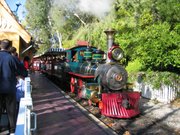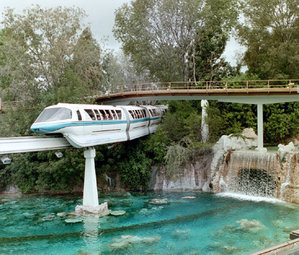Transportation within Disneyland Parks
Walt Disney had a longtime interest in transportation, and railroads in particular. He had built a miniature live steam backyard railroad, the “Carolwood Pacific Railroad”, on the grounds of his own home. Therefore a number of different modes of transport were incorporated into the park. The transportation systems are in some respects intended more as entertainment or sightseeing rides than as a means of transporting guests, such as the “Casey Junior” train ride.
Disneyland Railroad
 Disneyland incorporates a steam railroad, the Disneyland Railroad. Originally known as the Disneyland and Santa Fe Railroad, it was sponsored by the Atchison, Topeka and Santa Fe Railway until 1974. Laid to three-foot gauge, the most common narrow gauge measurement used in North America, the railroad is laid in a continuous loop around the park. All the Disneyland locomotives burn diesel fuel, which is less polluting (though more expensive) than the coal, wood, or heavy “Bunker C” oil normally used on steam locomotives.
Disneyland incorporates a steam railroad, the Disneyland Railroad. Originally known as the Disneyland and Santa Fe Railroad, it was sponsored by the Atchison, Topeka and Santa Fe Railway until 1974. Laid to three-foot gauge, the most common narrow gauge measurement used in North America, the railroad is laid in a continuous loop around the park. All the Disneyland locomotives burn diesel fuel, which is less polluting (though more expensive) than the coal, wood, or heavy “Bunker C” oil normally used on steam locomotives.
Originally, two trains could operate on the railroad, running in opposite directions. A passing track was incorporated at Main Street station where one train had to wait to allow the other to pass. Later, for safety reasons and to allow the use of more than two trains, the line was changed so that trains in normal service run in a clockwise direction only. The passing track was disconnected and now is only used to display a handcar. The 1958 addition of the “Grand Canyon/Primeval World” diorama necessitated a change in the rolling stock as well; instead of facing forward, the benches of the new flatcars now faced right so that the diorama could be better enjoyed by the passengers. Five open-air, clerestory-roofed observation cars with forward-facing seats dating from the park’s opening were returned to service in 2004 after undergoing a three-year restoration.
Another detail dating from the park’s opening can be seen from the railroad. As the train passes behind the “it’s a small world” attraction in Fantasyland, it crosses a service road that is protected by two miniature wigwag crossing signals. Santa Fe offered the use of full-scale crossing signals, but Disney declined as they would be out of scale with the trains. These scaled-down replicas were designed and built by the San Bernardino shops of the Santa Fe Railroad as a gift to Disneyland. They operate with automotive windshield wiper motors.
The Walt Disney Company constructed the original two locomotives in its own workshops under the supervision of Roger E. Broggie. Patterned after the Lilly Belle, a miniature steam locomotive Broggie had made for Walt’s backyard Carolwood Pacific Railroad, these were also models of classic “Wild West” style American 4-4-0s, but built to a larger three-fifths scale. No. 1 was given a big wood-burning ‘balloon’ stack and a large, pointed pilot (cowcatcher) while No. 2 was given a straight stack and smaller pilot common to East Coast coal-burning locomotives.
Two more locomotives were later acquired from outside sources, since this was cheaper than building new ones and since many narrow-gauge lines were closing down and selling their equipment. All three were given extensive renovations before entering service, including new boilers. No. 4 is a “Forney” locomotive, a type of tank locomotive. As an 1894 product of the Baldwin Locomotive Works, No. 4 is the oldest locomotive in service at any Disney property.
In 2004, Disney purchased the inoperable Maud L locomotive from the Cedar Point Amusement Park in Sandusky, Ohio, and sent it to a Southern California shop to restore it and transform it into a Disneyland Railroad locomotive. This 1902 Baldwin loco will be Disneyland Railroad train #5, and will be the first Disneyland Railroad train added since 1959. The train will be named after the late Ward Kimball, one of Disney’s Nine Old Men.
The railroad reopened in March 2005 after undergoing a three-month restoration to bring the roadbed back to gauge in time for the park’s fiftieth anniversary. It is the most prolonged closure of the railroad in park history.
Disneyland Monorail
 One of Disneyland’s signature attractions is its Alweg monorail system, installed in 1959. The monorail track has remained almost exactly the same since 1961, aside from small alterations while Disney’s California Adventure and Downtown Disney were being built. The trains themselves have received multiple updates; the most recent was in 1987 when more modern trains built by Ride and Show Entertainment eliminated the old ALWEG Buck Rogers-style trains. The next update will be around 2006 or 2007. The monorail shuttles visitors between two stations, one in Disneyland itself (in Tomorrowland) and one outside the park, originally at the Disneyland Hotel but now, after the 2001 remodel, at the Downtown Disney shopping complex. It follows a 2.5 mile (4 km) long route designed to show off the park from above. Three generations of monorail cars have been used in the park, since their lightweight construction means they wear out quickly.
One of Disneyland’s signature attractions is its Alweg monorail system, installed in 1959. The monorail track has remained almost exactly the same since 1961, aside from small alterations while Disney’s California Adventure and Downtown Disney were being built. The trains themselves have received multiple updates; the most recent was in 1987 when more modern trains built by Ride and Show Entertainment eliminated the old ALWEG Buck Rogers-style trains. The next update will be around 2006 or 2007. The monorail shuttles visitors between two stations, one in Disneyland itself (in Tomorrowland) and one outside the park, originally at the Disneyland Hotel but now, after the 2001 remodel, at the Downtown Disney shopping complex. It follows a 2.5 mile (4 km) long route designed to show off the park from above. Three generations of monorail cars have been used in the park, since their lightweight construction means they wear out quickly.
As of 2004, three monorail trains, Monorail Red, Monorail Blue, and Monorail Purple, are in regular service. A fourth train, Monorail Orange, was removed from service and shipped to Disney’s engineering department in Glendale for disassembly and study so that new blueprints can be created from it, because ALWEG, the company which built the original monorail trains, has gone out of business, and the current trains, built by Ride & Show Entertainment in 1987, use some of the same parts as the ALWEG trains did.
Disneyland had signed a contract with the Alweg company which required the Alweg name to be displayed on the monorail. This conflicted with the contract with the Santa Fe that only their name could be associated with railroad attractions at the park. This caused a rift between Disneyland and the Santa Fe railroad, and eventually caused the breakdown in their relationship and the removal of Santa Fe sponsorship from the Disneyland Railroad.
Main Street vehicles
A number of vehicles, including a double-decker bus, a horse-drawn streetcar, an old-fashioned fire engine, and an old-fashioned automobile, are available for rides along Main Street, U.S.A.
The fire engine was built for Walt Disney, who used it to drive around the park and host celebrity guests. The horseless carriages are modeled after cars built in 1903. They (as well as the fire truck) have two cylinder, four horsepower (3 kW) engines and manual transmission and steering.
Skyway
The Disneyland Skyway, “the first aerial tramway of its kind in the United States”1, was one of the signature attractions at the park. Opened in 1956 by Walt Disney himself, it shuttled passengers between Fantasyland and Tomorrowland 100 feet (30 m) above the ground, giving passengers fantastic views of Sleeping Beauty Castle, the Matterhorn (which was built around the Skyway in 1959), and the Autopia. A distinctive feature was that Disneyland maintained the ‘on-stage/backstage’ illusion to Skyway guests, covering any sites that would be unsuitable to guests that were also hidden to guests on foot.
Due to the enormous impending cost to retrofit the Skyway for earthquake safety and handicap accessibility, the attraction closed permanently on November 10, 1994. Four years later, Tokyo Disneyland removed their Skyway; finally, in 1999, Walt Disney World’s Magic Kingdom removed theirs. No Skyways are left at any Disney park (Disneyland Paris never had a Skyway attraction).
The Tomorrowland station remained and was used as a maintenance bay for Rocket Rods beginning in 1998. It was removed shortly after the Rocket Rods closed in spring 2001.
The Fantasyland station remains.
Autopia
The Disneyland Autopia opened with the park in 1955, and represented a future look at what would become America’s multilane limited-access highways that were still being developed (President Eisenhower had yet to sign the Interstate Highway legislation at the time Disneyland opened).
Robert Gurr designed the original Autopia cars to be reminiscent of Ferraris. In 1967, the cars were redesigned to resemble the popular Chevrolet Corvette. This car design was used through 2000, when the entire ride was re-themed and modernized. The new cars resemble those used in television commercials for Chevron and are in one of these three styles:
- Suzy the zippy compact
- Sparky the sports car
- Dusty, an S.U.V.
